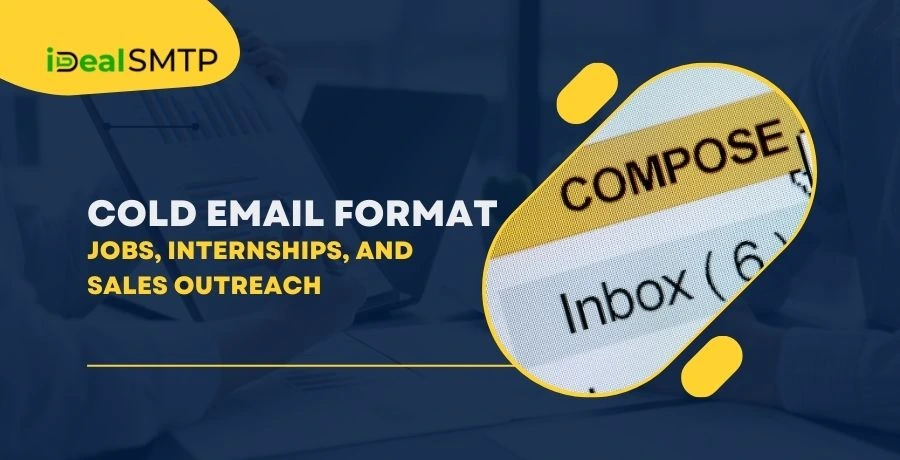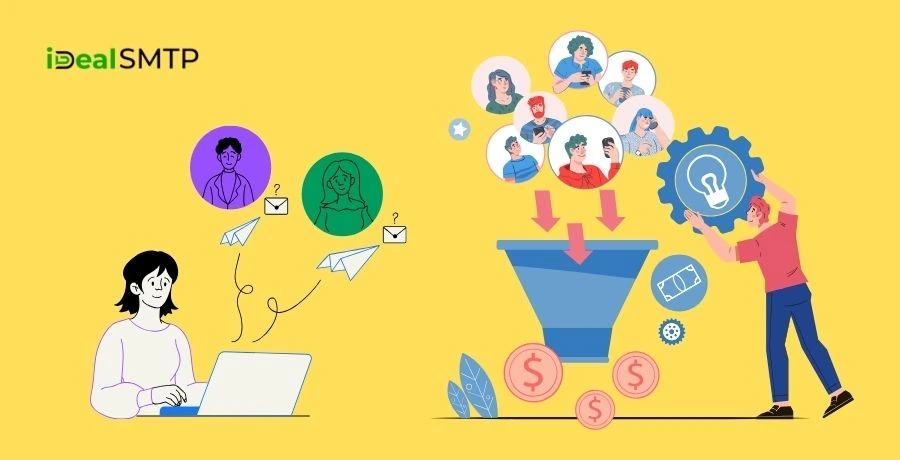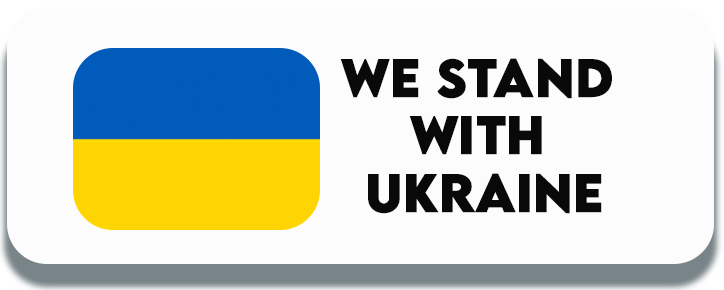Cold emailing has become a vital strategy for professionals, businesses, and students. Whether you’re reaching out for a job, internship, or sales opportunity, the format of your email can make or break your response rate.

In this comprehensive blog, we will explore the cold email format, how to craft the best one for different goals, and how email marketing tools like bulk email servers can enhance your outreach campaigns.
Table of Contents
Pricing
| Trail Plan | Standard Plan | Premium Plan | Professional Plan |
| $50 | $145 | $185 | $225 |
| Sending Limit | Sending Limit | Sending Limit | Sending Limit |
| 1000 Emails/Hour | 1500 Emails/Hour | 3000 Emails/Hour | 5000 Emails/Hour |
Understanding Cold Emails
A cold email is an unsolicited email sent to someone with whom you have no prior relationship. Unlike spam, cold emails are usually personalized and sent with a specific purpose. The sender often seeks to build a connection, request an opportunity, or offer a product or service.
The effectiveness of a cold email largely depends on its format. A poorly written email is likely to be ignored or marked as spam. A well-formatted cold email, on the other hand, can open doors, start conversations, and even convert leads.
Why Cold Email Format Matters
The structure of your email determines how your message is perceived. A clear, concise, and professional cold email format ensures that your recipient understands your intent quickly. A good format improves readability, builds trust, and increases the likelihood of a reply.
Most people spend only a few seconds reading an email before deciding whether to continue or delete it. This is why following the best cold email format is essential if you want to stand out in a crowded inbox.
The Basic Structure of a Cold Email
Before diving into specialized formats for jobs, internships, or sales, let’s understand the core elements of an effective cold email format:
- Subject Line- The first thing the recipient sees.
- Greeting- A polite and personalized salutation.
- Introduction- Who you are and why you’re reaching out.
- Body- What you want and why it matters.
- Call to Action (CTA)- What the recipient should do next.
- Signature- Your name and contact information.
Each of these elements plays a role in how your email is received and acted upon.
Best Cold Email Format for General Outreach
When reaching out to someone new, the goal is to be respectful, relevant, and clear. The best cold email format keeps things short but impactful. Avoid long paragraphs and jargon. Use language that is easy to understand and gets straight to the point.
Start with a strong subject line that creates curiosity. Follow up with a friendly greeting and a sentence about who you are. Your body paragraph should clearly state why you are contacting the person. End with a soft but direct call to action, like scheduling a call or asking for a response.
This format works well in a variety of industries and can be adapted depending on the situation.
Cold Email Format for Job Applications
Job seekers often feel awkward sending unsolicited emails to potential employers. However, with the right cold email format for job, you can create opportunities that don’t exist in public listings.
Start by researching the company and the person you’re contacting. Customize your email to reflect your understanding of their business. Mention your skills, experience, and how you can add value.
An ideal cold email format for job includes a subject line like “Experienced Digital Marketer Interested in Opportunities at [Company Name]” or “Exploring Job Openings in [Department Name]”.
In the body, introduce yourself and explain how your experience aligns with the company’s goals. Provide a link to your resume or LinkedIn profile and politely ask if there are any upcoming openings or if they’re open to discussing potential opportunities.
This personalized approach is much more effective than sending a generic application to a job board.
Cold Email Format for Internship Requests
Students and recent graduates often use cold emailing to secure internships. The cold email format for internship is slightly different from job emails because the focus is more on learning than experience.
Begin with a friendly subject line like “Interested in Internship Opportunities with [Company Name]” or “Seeking Marketing Internship – Passionate and Eager to Learn”.
Your introduction should highlight your academic background and any relevant coursework or projects. In the body, express your enthusiasm for the company and your willingness to contribute and grow. Attach your resume and ask if there are any internship openings.
Companies often appreciate proactive students and may even create internship positions for the right candidate.
Best Cold Sales Email Format to Convert Leads
Salespeople rely heavily on email to generate leads and build relationships. The best cold sales email format grabs attention, builds trust, and encourages action, all in a few sentences.

The subject line is crucial. Use something personalized or relevant, like “Quick Question About [Recipient’s Company]” or “Boost Your Email Deliverability in 7 Days”.
Start your email by referencing a recent news item, social media post, or a challenge the company may be facing. Introduce your product or service as a solution. Use a friendly and persuasive tone, not pushy or desperate. End with a simple call to action, like scheduling a demo or replying for more info.
Sales professionals often use bulk email servers to send out cold emails at scale, but personalization is still key. Segment your list and tailor each email to the recipient’s role or industry.
How Email Marketing Supports Cold Emailing
Email marketing is not just for email newsletters or promotions. It’s also a powerful strategy to support your cold outreach. Using professional tools, you can automate your campaigns, track open rates, and manage responses efficiently.
Email marketing platforms allow you to test different subject lines and formats, so you can see what works best for your audience. These insights can significantly improve your cold email results.
Furthermore, tools like bulk email servers help you scale your outreach while maintaining high deliverability. You can manage large contact lists, schedule emails, and send personalized messages automatically.
Why Bulk Email Servers Are Important
When sending a large volume of emails, whether for jobs, internships, or sales, using a bulk email server is essential. These servers are designed to handle mass emailing without being flagged as spam.
Unlike traditional email services like Gmail or Outlook, bulk email servers allow you to send thousands of emails per day with detailed tracking and bounce management. This is especially useful for sales campaigns and large internship drives.
Also, these servers provide better authentication (SPF, DKIM, and DMARC), ensuring that your emails land in the inbox and not the spam folder. Deliverability is everything in cold outreach.
Crafting Cold Emails that Work: Tips and Best Practices
While the format is critical, your content also matters. Use short paragraphs and plain language. Avoid attachments unless necessary. Always include a clear call to action.
Personalization is what sets a cold email apart from spam. Use the recipient’s name, mention their company or recent activity, and tailor your offer or request to their specific needs.
Timing also matters. Avoid weekends or late-night emails. Mid-morning on Tuesdays and Wednesdays often yields the best open rates.
Finally, always follow up. A single email rarely gets a response. A polite follow-up after a few days can dramatically increase your chances of getting noticed.
Real-World Examples of Effective Cold Email Formats
Let’s look at a few short samples based on different goals:
Cold Email for a Job:
Subject: Marketing Professional Open to Opportunities at [Company Name]
Hi [Name],
I’m [Your Name], a digital marketing specialist with 4 years of experience in SEO and PPC. I admire the innovative campaigns your team is running at [Company]. I’d love to explore if there are any opportunities to contribute my skills.
Here’s my LinkedIn: [Link]
Would you be open to a quick chat next week?
Best regards,
[Your Name]
Cold Email for Internship:
Subject: Passionate Student Seeking Internship at [Company Name]
Hi [Name],
My name is [Your Name], and I’m currently pursuing my bachelor’s in Computer Science. I’ve worked on several coding projects and am particularly excited about [Company]’s AI research.
Is there any chance I could intern with your team this summer?
Thanks,
[Your Name]
Cold Sales Email:
Subject: Quick Idea to Boost Your Sales Funnel
Hi [Name],
I noticed your company is expanding into new markets. At [Your Company], we help businesses like yours automate lead nurturing and increase conversion rates by 25%.
Would you be open to a 10-minute call to explore this?
Looking forward,
[Your Name]
Each of these emails follows a clean, cold email format that’s tailored to the audience and objective.
Common Mistakes to Avoid in Cold Emails
One of the biggest mistakes is being too generic. Using the same template for everyone is ineffective. You must personalize each message, even if it’s a mass campaign.
Another mistake is writing too much. Keep your email short and easy to scan. Long-winded introductions and unnecessary backstory will lose the reader’s interest.
Also, avoid sending cold emails from personal Gmail accounts if you’re doing it at scale. Instead, use a dedicated domain and a bulk email server to ensure deliverability.
And lastly, never forget to proofread. Spelling and grammar errors reduce your credibility and professionalism.
How to Track the Success of Your Cold Emails
Tracking is essential to see what works and what doesn’t. With email marketing tools and bulk email servers, you can monitor open rates, click-through rates, bounce rates, and replies.

If your open rates are low, your subject line or sending time might be the issue. If you’re getting opens but no replies, your message might not be compelling enough.
Use A/B testing to experiment with different formats. Tweak your subject lines, CTAs, and introductions to see what resonates most with your audience.
Legal Considerations for Cold Emailing
While cold emailing is legal in most places, it must be done ethically. Always include an unsubscribe link if you’re sending emails at scale. Never buy email lists. Instead, build your list organically.
Make sure your emails comply with regulations like GDPR and CAN-SPAM. Your identity must be clear, and recipients must have the option to opt out.
A reputable bulk email server can help you stay compliant by including automatic unsubscribe links and privacy controls.
Conclusion
Cold emailing is not a one-size-fits-all strategy. Whether you’re a job seeker, student, or sales professional, using the right cold email format can dramatically improve your outreach success.
Use clear subject lines, write short and relevant messages, and always personalize your content. Combine these strategies with email marketing tools and bulk email servers to scale your outreach while maintaining quality.
Remember, the best results come from testing, tracking, and refining your format over time. Stick with it, and cold emailing can become a powerful tool for building your career, network, or business.
FAQs
Here are the top FAQs on the cold email format blog:
1. What is a cold email?
A cold email is an unsolicited message sent to someone with whom you have no prior relationship.
2. What is the best cold email format?
A short, personalized email with a strong subject line, brief value pitch, and a clear CTA.
3. How do I write a cold email for a job?
Introduce yourself, highlight your skills, show interest in the company, and include your resume or LinkedIn.
4. What is the format for an internship cold email?
Mention your education, express interest in interning, and attach your resume or project links.
5. How do I format a cold sales email?
Address a pain point, offer a solution, include social proof, and end with a CTA.
6. What is the best cold email format for job applications?
The best cold email format for job applications includes a personalized subject line, a short introduction highlighting your relevant skills, a body that expresses interest in the company or role, and a professional sign-off with links to your resume or LinkedIn. Keep the message clear and concise, focusing on the value you can offer.
7. How should I structure a cold email for an internship request?
A cold email format for internship requests should start with a respectful greeting, followed by a brief self-introduction, mention of your current academic status, and a clear explanation of why you want to intern with the recipient’s company. End with a polite request for internship opportunities and attach your resume or portfolio.
8. What elements make up the best cold email format?
The best cold email format includes: a catchy subject line, a personalized greeting, a brief and relevant introduction, a value-driven body, a clear call-to-action (CTA), and a proper signature. Personalization and clarity are essential for success.







